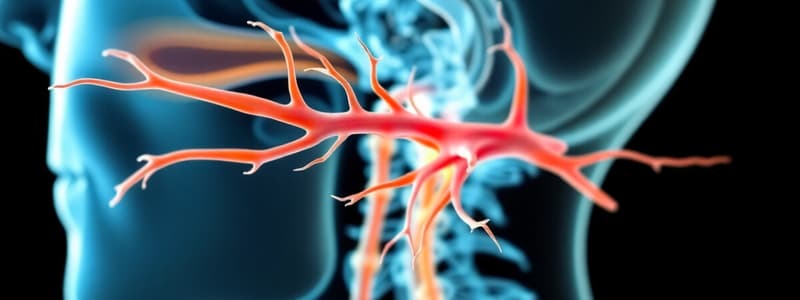Podcast
Questions and Answers
Which branch of the trigeminal nerve is responsible for providing sensory innervation to the lower teeth?
Which branch of the trigeminal nerve is responsible for providing sensory innervation to the lower teeth?
- Mental Nerve
- Supraorbital Nerve
- Infraorbital Nerve
- Inferior Alveolar Nerve (correct)
Which branch of the trigeminal nerve is responsible for providing sensory innervation to the skin of the forehead?
Which branch of the trigeminal nerve is responsible for providing sensory innervation to the skin of the forehead?
- Mental Nerve
- Inferior Alveolar Nerve
- Supraorbital Nerve (correct)
- Nasociliary Nerve
Which branch of the trigeminal nerve provides sensory innervation to the skin of the cheek and upper lip?
Which branch of the trigeminal nerve provides sensory innervation to the skin of the cheek and upper lip?
- Ophthalmic Nerve
- Mandibular Nerve
- Maxillary Nerve (correct)
- Lacrimal Nerve
Which two branches emerge from the Mandibular Nerve?
Which two branches emerge from the Mandibular Nerve?
Which branch of the trigeminal nerve is responsible for providing sensory innervation to the lacrimal gland and conjunctiva?
Which branch of the trigeminal nerve is responsible for providing sensory innervation to the lacrimal gland and conjunctiva?
Flashcards
Ophthalmic nerve
Ophthalmic nerve
A branch of the trigeminal nerve responsible for sensory innervation of the forehead and upper eyelid.
Maxillary nerve
Maxillary nerve
A branch of the trigeminal nerve that supplies sensory fibers to the midface, including the cheeks and upper lip.
Mandibular nerve
Mandibular nerve
The largest branch of the trigeminal nerve providing sensory and motor function to the lower jaw and teeth.
Trigeminal ganglion
Trigeminal ganglion
Signup and view all the flashcards
Auriculotemporal nerve
Auriculotemporal nerve
Signup and view all the flashcards
Study Notes
Trigeminal Nerve Branches
- The trigeminal nerve is a major cranial nerve (V) responsible for sensation in the face and motor functions of mastication.
- It has three major branches: ophthalmic (V1), maxillary (V2), and mandibular (V3).
- These branches are labeled in the image provided, with corresponding numbers.
- The ophthalmic branch (V1) provides sensory innervation to the upper face, including the forehead, scalp, and part of the orbit.
- The maxillary branch (V2) provides sensory innervation to the mid-face, including the cheeks, upper lip, and nasal cavity.
- The mandibular branch (V3) provides sensory innervation to the lower face, including the lower lip, chin, and part of the jaw, and motor function to the muscles of mastication.
- The image details the specific locations and pathways of each branch.
Studying That Suits You
Use AI to generate personalized quizzes and flashcards to suit your learning preferences.




